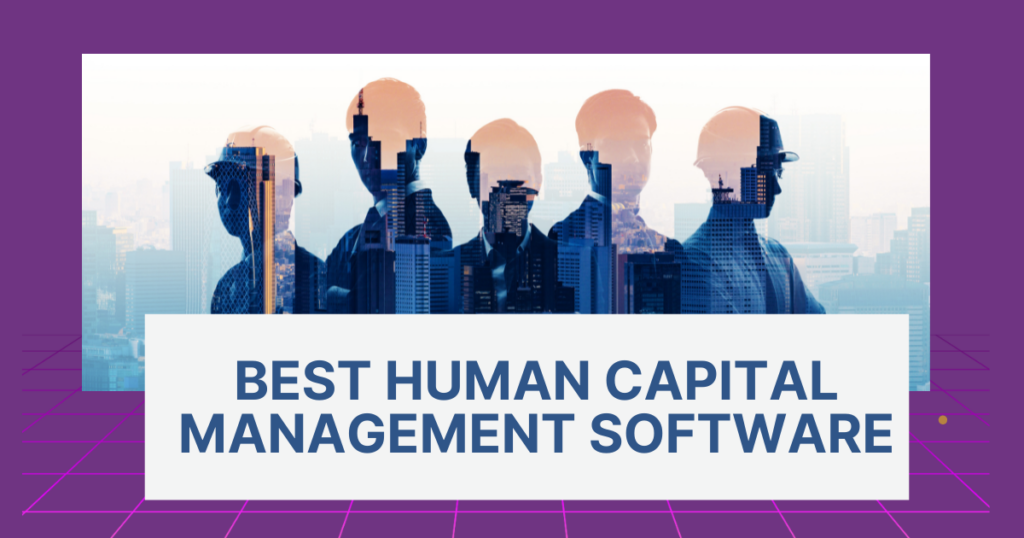
Explore the pinnacle of workforce management with the best Human Capital Management (HCM) software. Discover key features, real-world impact, and how these platforms streamline HR for organizational success. Welcome to the forefront of efficient workforce solutions.
Key Features and Functionality of Software
When it comes to Human Capital Management (HCM) software, the richness of its features and functionalities is what sets a top-tier system apart. These features are crafted to handle every facet of human capital management, turning complex HR tasks into streamlined, efficient processes. Let’s dive deeper into these essential features:
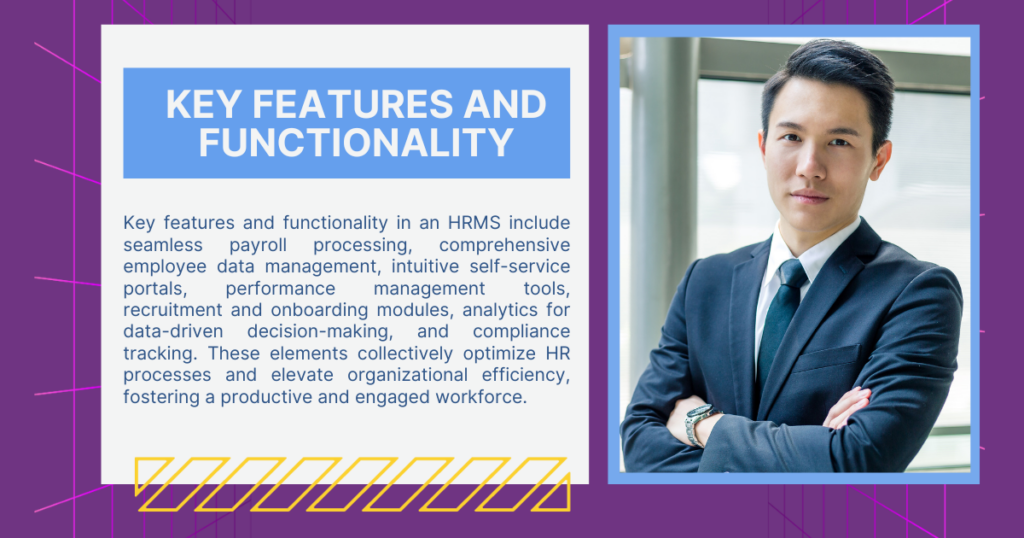
Comprehensive Employee Onboarding
Effective onboarding is the first step in building a strong employee-employer relationship. Top HCM software offers comprehensive onboarding tools that simplify and enhance this process. This includes automated paperwork, digital checklists, and interactive training modules. It ensures that new hires feel welcomed and well-informed from day one, setting a solid foundation for their journey in the organization.
Robust Performance Management
Performance management in leading HCM systems goes beyond traditional appraisals. These platforms offer continuous performance tracking, real-time feedback mechanisms, and goal-setting tools. They facilitate alignment of individual goals with organizational objectives, encouraging a culture of continuous improvement and personal development.
Efficient Payroll Processing
Payroll processing within HCM software is a game-changer for businesses. It automates calculations, tax withholdings, and salary disbursements, reducing the chances of errors. Advanced systems also handle varying pay structures, bonuses, and other compensation complexities, ensuring employees are paid accurately and on time.
Dynamic Benefits Administration
HCM software simplifies the complexities of benefits administration. It allows employees to choose from various benefit plans, tracks eligibility, and manages enrollments and changes with ease. This not only eases the administrative burden but also enhances the employee experience by providing them with clear options and control over their benefits.
Streamlined Talent Acquisition
Talent acquisition modules in HCM software transform recruitment processes. They offer tools for job posting, applicant tracking, interview scheduling, and candidate communications. By automating and organizing these tasks, businesses can attract and retain top talent more effectively.
AI-Driven Analytics
Artificial Intelligence (AI) in HCM systems brings predictive analytics and data-driven insights to HR. This technology can analyze patterns in employee data to help with decisions like hiring needs, identifying flight risks, and understanding employee engagement levels. AI-driven analytics turn data into strategic insights, guiding smarter workforce decisions.
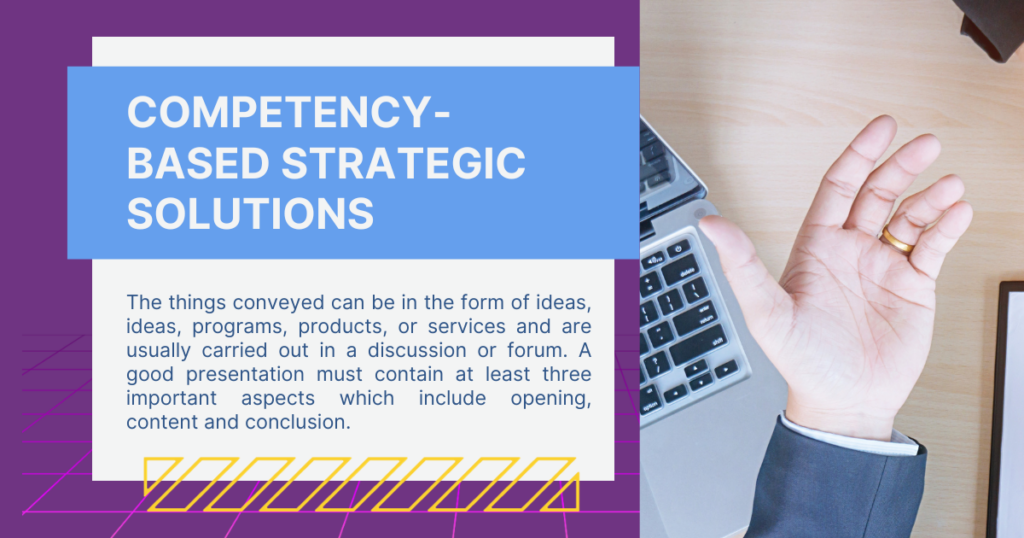
Mobile Accessibility
In today’s mobile-centric world, HCM software with mobile accessibility is crucial. It allows employees and managers to access information, complete tasks, and stay connected, regardless of their location. This feature is particularly beneficial for remote or on-the-go workforces, promoting flexibility and real-time communication.
Cloud-Based Operations
Cloud-based HCM software offers several advantages, including scalability, data security, and cost-effectiveness. It ensures that HR systems are always up-to-date with the latest features and compliant with legal standards. Additionally, cloud-based systems facilitate remote access, making it easier for teams spread across various locations to collaborate and manage HR tasks efficiently.
In conclusion, the key features and functionalities of top-notch HCM software provide a comprehensive toolkit for modern HR management. From onboarding to performance management and beyond, these features offer the agility and insights needed for informed decision-making, ultimately driving organizational success.
Top Benefits of Human Capital Management Software
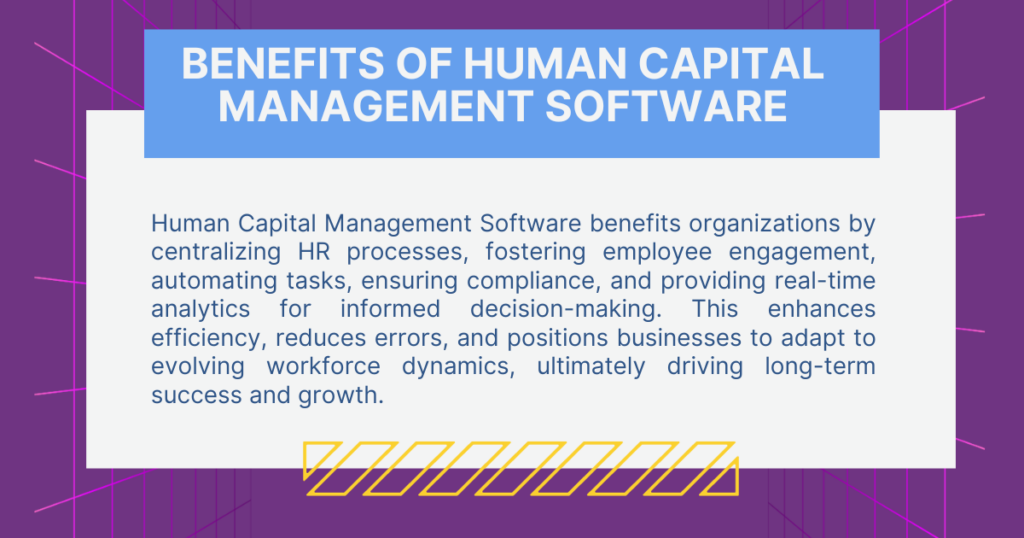
Implementing Human Capital Management (HCM) software brings transformative benefits to organizations. These benefits extend beyond mere automation of HR tasks; they redefine how businesses manage and nurture their most valuable asset – their people. Here’s a closer look at the top benefits:
Streamlined HR Processes
HCM software acts like the conductor of an orchestra, bringing harmony to various HR functions. It streamlines processes such as payroll, benefits administration, and employee data management. By automating repetitive tasks, it eliminates manual errors and frees up HR professionals to focus on more strategic initiatives. This streamlining leads to a more efficient HR department, capable of handling complex tasks with ease and precision.
Enhanced Employee Engagement
Employee engagement is crucial for organizational success, and HCM software plays a pivotal role in boosting it. Tools like employee self-service portals, feedback mechanisms, and recognition programs within the software empower employees.
They feel more involved and valued as they can access their data, provide inputs, and receive acknowledgments for their achievements. This heightened engagement leads to increased job satisfaction, lower turnover rates, and a more positive workplace culture.
Reduced Administrative Burdens
One of the most immediate impacts of HCM software is the significant reduction in administrative burdens. HR teams no longer need to drown in paperwork or juggle multiple spreadsheets. The software consolidates all HR-related data in one place, making it easier to manage and access. This efficiency not only saves time but also reduces the costs associated with manual HR management.
Improved Compliance with Labor Laws and Regulations
Navigating the complex maze of labor laws and regulations can be daunting. HCM software keeps businesses on the right side of these laws. It updates its systems to reflect the latest legal changes, ensuring that businesses remain compliant. This is particularly beneficial for companies operating in multiple regions or countries, where compliance requirements can vary significantly.
Uplift in Productivity and Efficiency
The automation and integration capabilities of HCM software lead to a significant uplift in overall productivity and efficiency. With streamlined processes and reduced manual intervention, employees can focus on higher-value tasks. This leads to quicker decision-making, better resource allocation, and ultimately, a more agile and responsive organization.
Improved Decision-Making with Data-Driven Insights
HCM software provides leaders and HR professionals with actionable insights derived from employee data. These insights help in making informed decisions regarding workforce planning, talent management, and organizational strategies. By understanding trends and patterns, businesses can anticipate future needs and make proactive changes.
Employee Satisfaction and Business Growth
Satisfied employees are the cornerstone of a successful business. HCM software contributes to this by ensuring that employee needs are met promptly and efficiently. Happy employees are more productive, creative, and loyal, which in turn drives business growth. Companies using HCM software often see a positive impact on their bottom line, as engaged employees contribute more effectively to business objectives.
In summary, the benefits of HCM software are far-reaching, touching every aspect of HR management. From streamlining administrative tasks to empowering employees and ensuring compliance, these platforms are indispensable tools for modern businesses looking to thrive in an increasingly competitive landscape.
How to Choose the Right HCM Software for Your Business
Selecting the right HCM software requires a careful assessment of your business needs, size, and growth trajectory. Consider factors like scalability, user-friendliness, customization options, integration capabilities, and cost-effectiveness. It’s about finding a solution that not only addresses your current requirements but also anticipates future HR challenges.
Case Studies: Successful Implementations
Real-world case studies of successful HCM software implementations can provide invaluable insights. These narratives often highlight the transformative power of HCM solutions in various industries, showcasing improved HR workflows, enhanced employee experiences, and measurable impacts on overall business performance. Healthcare Sector Efficiency
Background: A healthcare provider with a large employee base struggled with outdated HR systems, leading to inefficient HR processes and a lack of data-driven decision-making.
Implementation: The healthcare provider implemented a cloud-based HCM software, focusing on automated HR processes, advanced data analytics for workforce planning, and a robust learning management system for continuous employee development.
Outcome: The new system streamlined HR operations, reducing administrative work by 50%. The analytics capability provided insights that helped in better workforce planning and reduced turnover rates by 20%. Additionally, the learning management system improved compliance training completion rates by 60%.
Integrating HCM Software with Other HR Systems
The integration of Human Capital Management (HCM) software with existing HR systems is a vital step in building a cohesive and efficient HR ecosystem. This integration is not just about connecting different software solutions; it’s about creating a unified platform that enhances the functionality and efficiency of HR operations. Let’s explore this in more detail:
Importance of Seamless Integration
Seamless integration of HCM software with other HR systems, such as payroll, talent management, or time and attendance tracking, is crucial for several reasons:
Data Consistency: Integrated systems ensure that data is consistent across the board. When employee information is updated in one system, it automatically reflects in all others, reducing the risk of data discrepancies.
Improved Efficiency: Eliminating the need to switch between multiple systems or manually transfer data, integrated solutions save time and reduce errors, leading to more efficient HR processes.
Enhanced User Experience: A unified system provides a smoother experience for both HR professionals and employees. It simplifies tasks such as applying for leave, accessing payslips, or updating personal information.
Strategies for Effective Integration Implementing effective integration involves several key strategies:
Needs Assessment: Understand the specific needs of your organization. Identify which systems need to be integrated and the level of integration required.
Choosing the Right HCM Software: Select HCM software that offers robust integration capabilities. Look for solutions with APIs (Application Programming Interfaces) and pre-built connectors for ease of integration.
Data Mapping and Migration: Carefully plan the data mapping process to ensure all relevant data is accurately transferred from existing systems to the new HCM software.
Stakeholder Engagement: Involve all stakeholders, including HR, IT, and end-users, in the integration process. Their input is crucial for identifying potential issues and ensuring the system meets everyone’s needs.
Several organizations have successfully integrated their HCM software with other HR systems, reaping significant benefits:
A Large Retail Chain: Integrated their HCM software with their existing payroll and time tracking systems, leading to a 30% reduction in payroll processing time and more accurate timekeeping records.
A Global Technology Company: Connected their HCM platform with their talent management and learning management systems, resulting in more streamlined talent acquisition and development processes.
Overcoming Integration Challenges Integrating HCM software with existing systems can present challenges, such as compatibility issues, data security concerns, and resistance to change. Overcoming these challenges requires:
Technical Expertise: Work with IT professionals and software vendors who have experience in system integration.
Change Management: Implement a change management plan to address any resistance and ensure a smooth transition.
Continuous Monitoring and Support: Monitor the integrated system regularly to address any issues promptly and provide ongoing support and training to users.
The Future of Integration in HCM Software Looking ahead, the integration of HCM software with other HR systems is set to become more seamless and sophisticated. We can expect advancements in AI and machine learning to further automate data synchronization and predictive analytics, enhancing decision-making and operational efficiency.
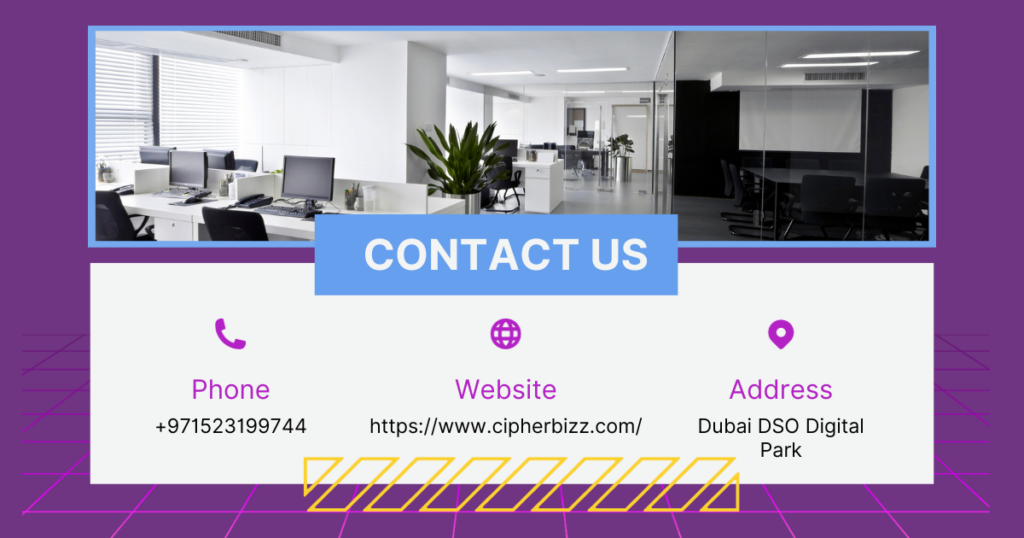
Emerging Trends in Human Capital Management Software
Adopting Human Capital Management (HCM) software is a significant step towards advancing HR capabilities, but it often comes with its share of challenges. Successfully navigating these hurdles is key to ensuring a smooth transition and achieving the full benefits of the software. Let’s explore these challenges in more detail and discuss strategies to overcome them.
Challenge 1: Employee Resistance to Change
Resistance to change is a natural human tendency, and it can be a significant barrier when implementing new HCM software.
Strategies to Overcome:
Effective Communication: Clearly communicate the benefits and the positive impact of the new HCM system on employees’ work lives. Transparency about what changes to expect can reduce anxiety and build trust. Involving Employees in the Process: Engage employees in the selection and implementation process. This can include surveys to understand their needs and concerns, and involving a representative group in software testing. Change Champions: Identify and train change champions within each department who can advocate for the new system and assist their colleagues. Challenge 2: Data Migration Complexities Migrating data from existing systems to a new HCM platform can be complex and fraught with risks like data loss or corruption.
Strategies to Overcome:
Detailed Planning: Develop a comprehensive data migration plan that includes data cleaning, mapping, and validation processes. Phased Approach: Consider a phased approach to migration, moving data in stages rather than all at once, to minimize risks.
Expert Assistance: Employ the services of data migration experts or use specialized tools designed for this purpose to ensure a smooth transition.
Challenge 3: Aligning Software with Business Processes Ensuring that the new HCM software aligns with existing business processes and practices can be challenging, especially in complex organizational structures.
Strategies to Overcome:
Process Mapping: Before implementation, map out existing HR processes and identify how they will integrate with the new system. This may also be an opportunity to optimize these processes.
Customization and Flexibility: Choose HCM software that offers a high degree of customization and flexibility to adapt to your specific business processes.
Iterative Feedback and Adaptation: Implement the system in a pilot department and gather feedback for improvements before a full-scale rollout.
Challenge 4: Continuous Training and Support Employees might struggle to adapt to the new system without adequate training and ongoing support.
Strategies to Overcome:
Comprehensive Training Programs: Develop a training program that caters to different user groups within the organization, considering varying levels of tech-savviness.
Accessible Support Resources: Create a support system that includes user manuals, FAQs, and a helpdesk for addressing user queries and issues. Regular Updates and Refreshers: Schedule regular training sessions to keep employees updated on new features or changes in the system.
Challenge 5: Ensuring User Adoption and Maximizing ROI Achieving high user adoption rates is crucial to maximize the return on investment (ROI) of the new HCM system.
Strategies to Overcome: User Engagement Metrics: Monitor metrics related to system usage and user engagement to identify areas where adoption may be lagging.
Incentivizing Use: Consider implementing incentives or recognition programs for departments or individuals who effectively use the system.
Continuous Improvement: Regularly seek user feedback to continuously improve the system and ensure it remains relevant and useful to the employees.
Security and Compliance Considerations
Security and compliance are paramount in choosing HCM software. The ideal platform should not only protect sensitive employee data but also ensure adherence to evolving data protection regulations and labor laws, safeguarding both the organization and its employees.
Conclusion
In summary, the best Human Capital Management (HCM) software is a crucial investment for streamlined HR processes, improved employee engagement, and long-term organizational success. Choose wisely to ensure efficiency, adaptability, and sustained growth.
